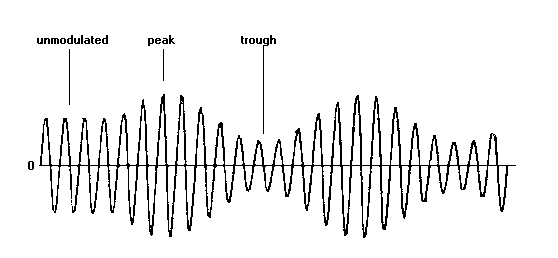|
If you connect a long wire to the output terminals of your Hi-Fi amplifier and another long wire to the input of another amplifier, you can transmit music over a short distance. DON'T try this. You could blow up your amplifier. 
A radio wave can be transmitted long distances. To get our audio signal to travel long distances we piggyback it onto a radio wave. This process is called
MODULATION.
The radio wave is called the CARRIER.
The audio signal is called the MODULATION.
At the receiving end the audio is recovered by a process called DEMODULATION.
From the diagram below, it can be seen that when the carrier is modulated, its amplitude goes above and below its unmodulated amplitude.
It is about 50% modulated in the diagram. The maximum percentage modulation possible is 100%. Going above this causes distortion.

Most broadcasters limit modulation to 80%.
Modulating the carrier frequency with an audio frequency produces two new frequencies. At this point it would be a good idea to read the page on
MIXERS. These new frequencies are called the upper and lower SIDEBANDS. The upper sideband is the carrier frequency plus the audio frequency. The lower side band is the carrier frequency minus the audio frequency.
Since the audio signal is not a single frequency but a range of signals (usually 20 Hz to 20 KHz) the sidebands are each 20Hz to 20 KHz wide.

If you tune across a station in the Medium Wave Band you will find that it takes up space in the band. This is called the signal
BANDWIDTH. This is the space taken by the upper and lower sidebands. In the the example given above it would be 40 KHz.
Since the Medium Wave is only 500 KHZ wide there would only be space for about 12 stations.
Therefore the bandwidth of stations is limited to 9 KHz, which limits the audio quality.
If there are two stations too close together, their sidebands mix and produce
HETERODYNE whistles.
Since both sidebands carry the same information, one side can be removed to save bandwidth.
This is SSB, single sideband transmission. |